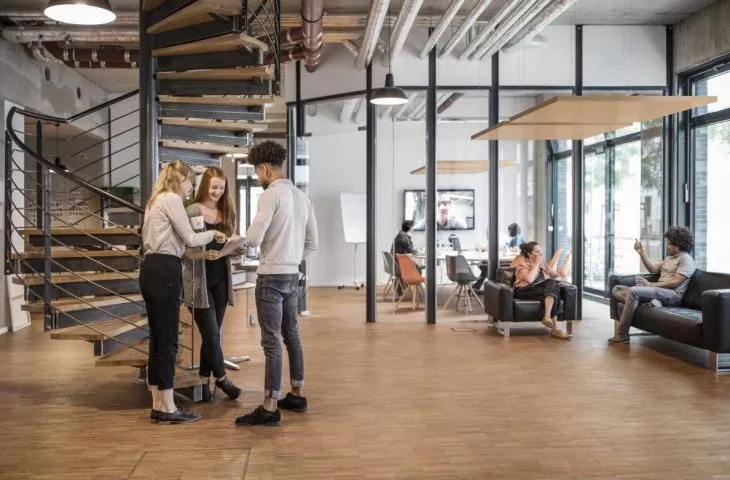Designing Acoustic Comfort in Offices.
From the series "Modern office buildings - 2020 trends".
How far in the office open space should the noise of conversations reach? How should sound in meeting areas and rooms? What affects employees' sense of acoustic comfort? As Ecophon, we help answer these questions and select effective solutions during the design process. Now that the office is competing with the home, and the office space itself should be as versatile as possible, acoustics play an even more important role than before.
Acoustics - the invisible architecture
The above speech by Julian Treasure entitled. "Why architects need to use their ears" has made him extremely popular. The material was shared on the non-profit platform Ideas worth spreading Ted.com and has been viewed there more than 1.3 million times. It talks about acoustics as an invisible architecture that affects people on many levels. Although much has changed in design approaches since that talk (in 2012), the role of sounds in our environment is still underestimated.
As a survey of 500,000 workers shows, including in Poland:
- acoustics is important for 7 out of 10 office users
- less than one in three people is satisfied with office acoustic conditions, the rest of employees complain more or less
- Of all the office comfort factors surveyed, acoustics has the largest gap between factor importance and satisfaction.
Ecophon Solo Hexagon acoustic ceiling island
© ECOPHON
Offices in the COVID era - acoustic comfort and the "hygiene factor"
The new situation can accentuate old noise problems. This is influenced by the increased frequency of video conferencing, the need for distance during physical meetings and the need for good conditions for individual work in concentration. The latter is a so-called hygiene factor for employees, without which they do not consider the office a productive place to work. In this regard, in turn, good acoustic conditions are provided by the home, with which the office now often competes (source: "Home Office Experience," Leesman, 2020).
Ecophon Solo Baffle ceiling acoustic islands
© ECOPHON
Sound perception
The acoustics of an office and how we perceive it is still problematic, because sound perception is affected by several factors. The same conditions can affect us differently, depending on individual characteristics and the type of work.
When performing more difficult tasks, as a rule, we all need relative quiet. When we perform, simple, tedious activities we need external stimuli that will make it easier to get through the task. However, it also depends on our personality and the response of the nervous system. Many studies show that introverts have a higher susceptibility to noise. They are highly reactive by nature, meaning that it only takes a small stimulus for their arousal level to become high enough that they function less well. Extroverts are often positively stimulated by noise, so that they reach their optimal level of arousal. This, however, is more true of standard tasks and situations where extroverts have a sense of control over the noise - they know they can take off their headphones with the music, leave a noisy coffee shop or change to a quieter place in the office.
Ecophon Solo printed acoustic ceiling island
© ECOPHON
Natural acoustic environment
Our hearing was developed in the process of evolution, when we lived mainly outdoors. That's where we perceive acoustic stimuli best - when sounds remain natural because they are not amplified by hard walls or ceilings and resound relatively quickly.
Modern offices, despite their ambition to get closer to nature, are still far from a natural environment from the point of view of acoustics. In addition to soft furniture, hard surfaces - reinforced concrete ceilings, glass walls - dominate. The industrial style, with plant accents, does not provide adequate, even attenuation of the room, hence employees complain about noise even in the most modern offices, where acoustics has not been considered as a component of the "hygiene factor."
Whether an employee will be able to focus is influenced not only by the acoustics of the workstation, but also by the acoustics of passageways and meeting areas. The acoustic comfort of the office must therefore be looked at holistically:
When designing office spaces, care should be taken to ensure that there is room for sound-absorbing material on the ceiling and/or walls, and furniture partitions should be selected for acoustic efficiency. It is also important to maintain appropriate distances between workstations and spaces with different functions, as well as employee education. It is important to confirm at the design stage whether the various zones of the office will have optimal acoustic absorption, how far the sound will reach, and what the reverberation rate of rooms and meeting areas will be.
Ecophon Solo Textile acoustic ceiling island
© ECOPHON
What answers are we looking for - selecting acoustic solutions
What do we want employees to hear in different areas of the office? How far should the sound of conversations travel? How should the sound be in the zones and meeting rooms? What sounds should dominate in common spaces? And finally - how will we achieve the desired effect? These questions should arise during office design. In the office acoustics planning process, as Ecophon, we help pose and answer them. We then determine measurable indicators, controlled during the creation of the space, and help select the optimal systems and products. Among them can be Akusto wall panels with any print, Solo islands covered with fabric or perforated steel or baffles in various shapes and colors or washable ceiling and wall panels with strict hygiene requirements.
Ecophon Akusto Wall C acoustic wall panel with print
© ECOPHON
A holistic approach based on sound acoustic data is important. As a result, sound control in the office becomes possible, and acoustic conditions support employees with different needs.
Magda SZUBERT
Concept Development Manager - Office Acoustics Ecophon Saint-Gobain
For more information, visit the company's ECOPHON, SAINT-GOBAIN page on the A&B portal.


































